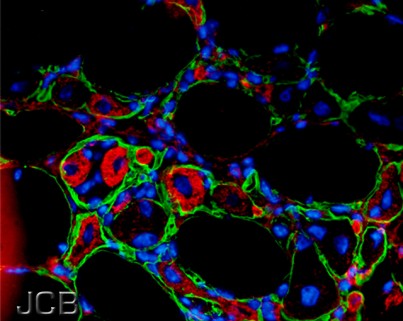Nanodiamonds are far too small to be seen by the naked eye, but everything changes if you make them glow! We at the Center for Sustainable Nanotechnology have developed a new way to make nanodiamonds absorb and then release light—a property known as fluorescence (see this explainer post). I just made these fluorescent nanodiamonds and did an experiment on them in order to see them glow. I put them in water, and with the help of scientists in the Goldsmith group here at UW-Madison I shined laserlight on them and here is what I saw through a microscope.
Glowing, twinkling nanodiamonds! Each little dot you see is light coming from a single nanodiamond (or maybe two or three clumped together). When I first saw this through the fluorescence microscope I was reminded of the nearly countless twinkling stars in the middle of the night. The nanodiamonds twinkle because they don’t always re-emit the laserlight they absorbed. Instead of being released as light, sometimes that laserlight energy is released in other ways, collectively known as non-radiative relaxation.
I’m excited about this breakthrough because when we put these nanodiamonds into biological systems (cells, organisms, cell membranes, etc.), we will be able to use this technique to watch individual nanodiamonds move around. This will allow us to better understand nano-bio interactions so we can design safer nanomaterials and also help develop the potential of nanodiamonds in the biomedical industry.

Finally, I would like to say that we don’t yet understand why these nanodiamonds we made are fluorescent. This is brand new! There is so much left to discover!
Acknowledgement: I am from Korea, so English is not my first language. Thanks to Lee Bishop for helping me write this post in English.
